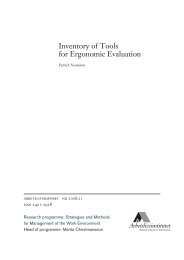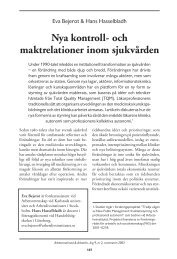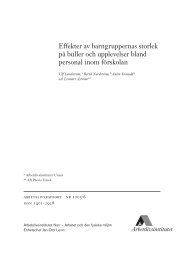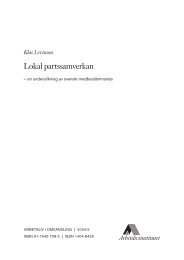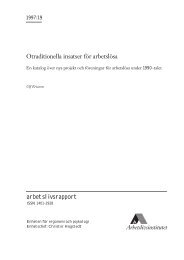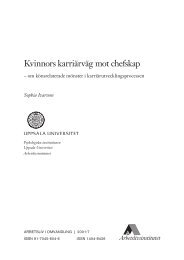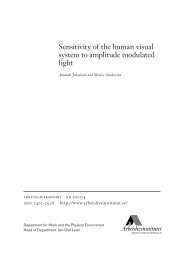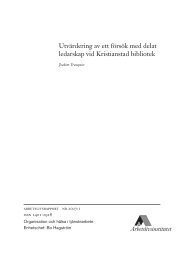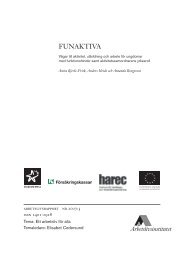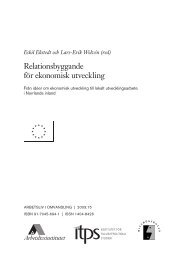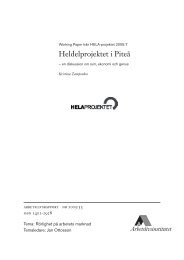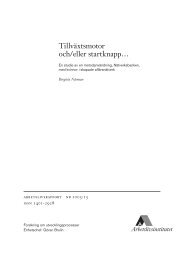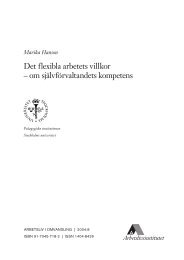Auktoritet och ansvar: Lärares fostrans- och omsorgsarbete i ... - DiVA
Auktoritet och ansvar: Lärares fostrans- och omsorgsarbete i ... - DiVA
Auktoritet och ansvar: Lärares fostrans- och omsorgsarbete i ... - DiVA
You also want an ePaper? Increase the reach of your titles
YUMPU automatically turns print PDFs into web optimized ePapers that Google loves.
importance of happiness as a state that ideally should characterise pupils lives, is<br />
related to different attitudes of schooling as a preparation for the future. Three<br />
types of preparation are distinguished: preparation for eternity, preparation for<br />
society and preparation for learning; three types that belong roughly to three<br />
different time periods (pre-modern, modern and late modern society). These<br />
three types of preparation give, respectively, the idea of happiness different<br />
meanings. When schooling is understood as a preparation for learning the tradition<br />
of the postponed happiness becomes challenged. A possible conclusion of<br />
this development is that teachers’ responsibility for the wellbeing of pupils becomes<br />
more present oriented.<br />
Chapter 9 [“Public sphere turned intimate”] analyses the process of making<br />
suffering visible. It is argued that the care of the suffering child historically has<br />
been hampered by the fact that the knowledge of the wellbeing of the child was<br />
restricted by the fact that schools were seldom seen as places for making the<br />
private public. When the social distance decreases, and with the advent of such<br />
things as the “log book” [loggboken], the increased contacts with parents, and<br />
with the practice of mentorship, it is argued that pupils (or parents) telling<br />
teachers about their private problems is made more likely, although this arguably<br />
does not apply to most pupils.<br />
Chapter 10 [“From school hygiene to a pedagogy of crisis”] discusses and<br />
contrasts two ways in which the idea of wellbeing of pupils has been discussed in<br />
the early and late 20 th century respectively. Under the headline of school hygiene,<br />
wellbeing and health was discussed during the first half of the 20 th century. The<br />
analysis is concentrated on the struggle against contagion. The second part of the<br />
chapter is about “crisis pedagogy”, or with another word, crisis management.<br />
Drawing on articles and handbooks in crisis management the aim is to understand<br />
in what ways the crisis pedagogy represents new ways of dealing with the<br />
suffering child. School hygiene and crisis pedagogy are both about wellbeing,<br />
but the first had “sickness” as the fundamental concept, whereas the later has<br />
“sorrow” as its fundamental concept. The former is characterised by a belief in<br />
progress and segregation, whereas the latter is characterised by a belief in inclusion<br />
and close personal relationships.<br />
In Chapter 11 [“Responsibility for the other”] the transformation of the caring<br />
aspects of teaching, discussed in the preceding chapters is discussed from two<br />
perspectives. First the mechanisms that make responsibility for the Other<br />
probable or less probable are discussed. The processes of intimisation, the<br />
present oriented culture (“schoolification”) and the fact that suffering in late<br />
modern societies is seldom viewed as created by impersonal factors (“relationisation”)<br />
are discussed. The conclusion of this is that the suffering child is more<br />
likely to become a problem that the teacher has to handle in late modern<br />
societies. The suffering child is less likely to be made invisible by the social<br />
distance between teachers and pupils, it can not be “cured” by the future, and it<br />
227




